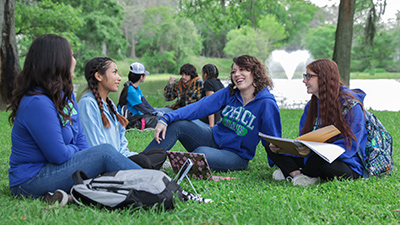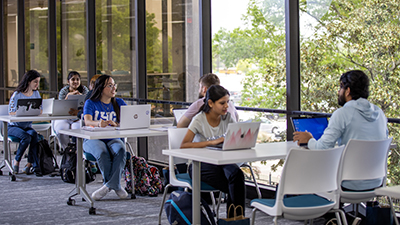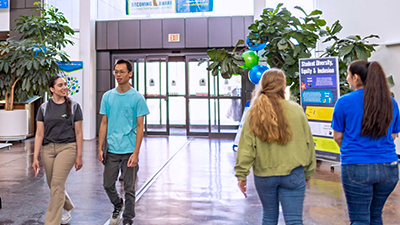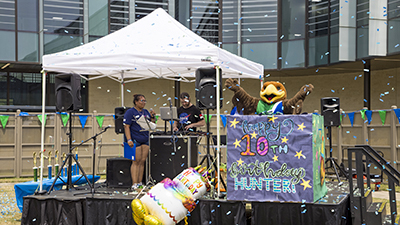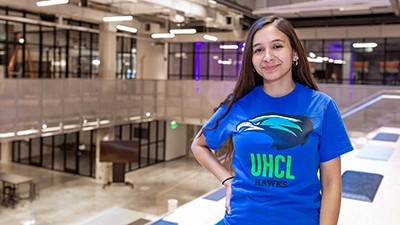
Student Loans at UHCL
University of Houston-Clear Lake wants to help you secure any loan you feel is necessary to pursue your college education. A college loan is like any other type of loan in the real world:
- You borrow a specific amount of money (from the federal government, bank, private individual, etc.); and
- You negotiate the terms under which you repay the loan (amount of interest, minimum payment amount, time frame of payback, etc.).
Before you start applying for loans, you should investigate the different types of loans available for most college students:
Loan Eligibility
For most federal loans received through your Free Application for Federal Student Aid (FAFSA), you must meet the following eligibility requirements:
- U.S. citizen or permanent resident
- An undergraduate or graduate student enrolled at least half time
- Complete a FAFSA
- Maintain satisfactory academic progress
- You don't exceed annual or lifetime total loan limits
- No credit check is required
Repayment Terms
With most federal loans, you have a 6-month grace period before starting repayment. This grace period begins in one of three scenarios: after graduation from college, dropping below half-time, or leaving school for any other reason. Repayment options vary, and under some circumstances, you may be eligible to postpone or temporarily reduce payments. The standard loan repayment is a 10-year plan; though other repayment plans such as graduated or extended repayment plans may be available.
Details of the Direct Loan Process
Most federal loans – and all Stafford Loans, the most common federal loan – are Direct Loans. This means you work with UHCL and the U.S. Department of Education to secure your loan. It's the simplest, most cost-effective and safest program available. What does this mean to you?
- If you are at least half time at UHCL, you may qualify for a low-interest Federal Direct Loan. Federal Direct loans are available for both undergraduate and graduate students. You can use the loans to pay tuition and fees, as well as some other living expenses (such as room and board, books and transportation). You can receive Federal Direct loans as subsidized, unsubsidized, or as a combination of the two.
- Direct loans can be subsidized – interest-free while you're in school – if you qualify. To qualify for a subsidized loan, complete the FAFSA form. If your FAFSA results demonstrate financial need, you can qualify for a subsidized loan. The government will pay the interest on your loan while you are in school. Only undergraduates are eligible for subsidized loans.
- Unsubsidized Direct loans are also available with low interest rates and favorable deferment options. Although you are charged interest on an unsubsidized loan, you have the same low interest rate, deferment, and repayment options. You can save money by paying the interest on an unsubsidized loan quarterly, rather than allowing it to add up until you enter the repayment period.
- When interest is due on unsubsidized loans, you accrue interest on your loan from the time you receive your loan until you pay it in full. You can put off paying interest while you are in school and enrolled at least half time. However, if you put it off, it is added to the original balance of the loan. If you can, pay the interest when you receive your quarterly interest statement.
Additional College Loan Information
The Department of Education central database for student aid is the National Student Loan Data System (NSLDS). Schools and agencies that guarantee loans, the Pell grant program, and other DOE programs report data here. The NSLDS Student Access website is available 24 hours a day, 7 days a week. You can inquire about loans or grant amounts, outstanding balances, loan status and other disbursements. To use the NSLDS website, you need your Federal Student Aid ID (known as FSAID). This is the same FSAID used when filling out your FAFSA.
Federal Direct Loan Interest Rates by Disbursement Dates
| Loan Type | First Disbursed between July 1, 2024 and June 30, 2025 |
|---|---|
| Direct Subsidized and Unsubsidized Loans (for Undergraduate Students) | Fixed at 6.53% |
| Direct Unsubsidized Loans (for Graduate or Professional Students) | Fixed at 8.08% |
| Direct PLUS Loans (Parents and Graduate or Professional Students) | Fixed at 9.08% |
UHCL Three-year Cohort Default Rate
The U.S. Department of Education releases official cohort default rates once per year. A cohort default rate is the percentage of a school's borrowers who enter repayment on Direct Loan Program loans during a federal fiscal year (October 1–September 30) and default or before the end of the second following fiscal year. The FY 2021 national cohort default rate is 0%. Please see UHCL's student loan cohort default rate for the last three official calculations in the chart below.
| Fiscal Year | Cohort Default Rate |
|---|---|
| 2021 | 0.0% |
| 2020 | 0.0% |
| 2019 | 0.4% |
The number of unique Federal Student Loan borrowers at UHCL in 2022 was 4,117.
